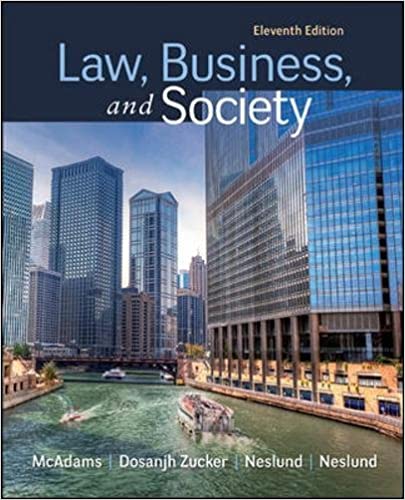
Law, Business and Society 11th Edition by Tony McAdams
Edition 11ISBN: 978-0078023866
Law, Business and Society 11th Edition by Tony McAdams
Edition 11ISBN: 978-0078023866 Exercise 27
Abercrombie Fitch (A F or Abercrombie), the clothing retailer, was accused in 2003 of maintaining a virtually all-white image by discriminating in recruiting, hiring, and promoting women and minorities. A nationwide class-action lawsuit was filed claiming that Abercrombie disproportionately assigned minority employees to stockrooms and other jobs out of the public eye, while white employees were conspicuously on display as a means of projecting the company's "clean-cut, classic" image.
Abercrombie denied the charges, but it decided to settle in 2005 by agreeing to pay $40 million along with $10 million in attorney fees and other expenses. The settlement also required the company to promote diversity in its workforce. In addition, Abercrombie agreed to manifest a more diverse image in its marketing materials, including its catalogs, shopping bags, and store posters.
In September 2013, Abercrombie settled two religious discrimination lawsuits filed by the federal government's Equal Employment Opportunity Commission, both involving Muslim teens who wore headscarves (hijabs). One teen had been terminated from her stockroom job at Hollister for refusing to remove her hijab in violation of the store's "Look Policy," and another who was denied employment at an Abercrombie outlet had been asked about her hijab and religion during her interview. Two federal judges had ruled against A F prior to the settlement, under which the store paid $71,000 and promised to change its policies. However, the next month, a federal appellate court judge reversed a trial court's ruling against Abercrombie in a third religious discrimination lawsuit involving a refusal to hire based on the applicant's hijab. The Court agreed with A F that its "Look Policy" was necessary to maintain its "classic East Coast collegiate style of clothing."
A F defenders have argued that the clothier has the right to promote an image of its choice as a means of making a profit.
a. The law aside, is Abercrombie simply wrong to project an image that, however it is labeled, may be described as a "white image" if, indeed, it does so Explain.
b. Would it be wrong for a store promoting a "hip hop" image to refuse to hire an applicant because she wears a hijab How about if that store refused to hire a white applicant based on race Explain.
c. What if a store selling hunting and fishing gear refused to hire African-American applicants for cashier and sales associate positions-would that be wrong Explain.
Abercrombie denied the charges, but it decided to settle in 2005 by agreeing to pay $40 million along with $10 million in attorney fees and other expenses. The settlement also required the company to promote diversity in its workforce. In addition, Abercrombie agreed to manifest a more diverse image in its marketing materials, including its catalogs, shopping bags, and store posters.
In September 2013, Abercrombie settled two religious discrimination lawsuits filed by the federal government's Equal Employment Opportunity Commission, both involving Muslim teens who wore headscarves (hijabs). One teen had been terminated from her stockroom job at Hollister for refusing to remove her hijab in violation of the store's "Look Policy," and another who was denied employment at an Abercrombie outlet had been asked about her hijab and religion during her interview. Two federal judges had ruled against A F prior to the settlement, under which the store paid $71,000 and promised to change its policies. However, the next month, a federal appellate court judge reversed a trial court's ruling against Abercrombie in a third religious discrimination lawsuit involving a refusal to hire based on the applicant's hijab. The Court agreed with A F that its "Look Policy" was necessary to maintain its "classic East Coast collegiate style of clothing."
A F defenders have argued that the clothier has the right to promote an image of its choice as a means of making a profit.
a. The law aside, is Abercrombie simply wrong to project an image that, however it is labeled, may be described as a "white image" if, indeed, it does so Explain.
b. Would it be wrong for a store promoting a "hip hop" image to refuse to hire an applicant because she wears a hijab How about if that store refused to hire a white applicant based on race Explain.
c. What if a store selling hunting and fishing gear refused to hire African-American applicants for cashier and sales associate positions-would that be wrong Explain.
Explanation
The given case is of a clothing store wh...
Law, Business and Society 11th Edition by Tony McAdams
Why don’t you like this exercise?
Other Minimum 8 character and maximum 255 character
Character 255


